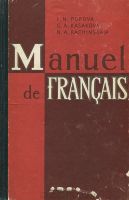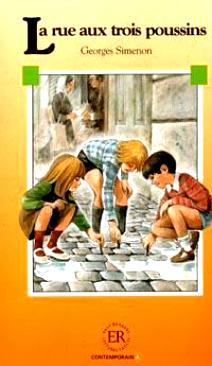Last year, I decided to continue learning French, my second foreign language. I decided to learn the language on my own, based on the grammar-translation method. I set myself the goal - to reach the level of free reading of articles on the French Wikipedia. In order to fully concentrate on this goal, I postponed the study of the conversational part for later.
I took the first approach to French almost 8 years ago. Inspired by the success in English, which I rather unorganized taught from school and which sharply went uphill when I entered a foreign company, I decided to take up French. As you know, in English, a good half of words are of Romance, so I wanted to strengthen my English with the knowledge of French. I also wanted, for example, to be able to read War and Peace, without the need to refer to footnotes in French quotations. I was not very interested in the sound of the French language and French culture, and I did not have any romantic incentives to study the “language of love”.
Then, 8 years ago, I managed to work out for 3 months with a teacher, concentrating mainly on the pronunciation and memorization of dialogues from the book Tout Va Bien. After that, I had a long break until recently.
The second time I started working on the grammar-translation method, since it most fully meets my learning objectives. I had a positive experience of using it in courses during school when I was learning English. Half the class we recorded the topic of grammar, the other half of the class, slowly, word by word, in turn, translated a collection of adapted stories. 1-2 paragraphs of this text were given to the house and it was a real test, when you look at almost every word in the Muller dictionary, you can hardly move forward, getting great pleasure from contact with the real language.
I did not consider the courses for two reasons: first, all modern courses that I know have a pronounced communicative orientation; second, I wanted to check the possibility of independent work with the language.
I got ideas for self-study from the wonderful book of the Swedish polyglot
Erik Gunnemark, “The Art of
Learning Languages”:

In terms of learning new languages, he suggests the following: you need to start with a minimum, carefully selected and free from details and difficulties. This applies to the dictionary (not to learn useless names of animals, products and other rare words), grammar (only basic things) and a set of key phrases (minilex - a set of standard expressions necessary for basic conversation that you need to learn by heart). The most important thing is to provide yourself with immersion in the language: for conversational - to listen a lot, for reading - to read a lot, and it’s better to start with children's books and textbooks, because they have simple language. If interested,
here you can find additional information on these ideas.
Inspired by this book, the first thing I decided to refresh the phonetics and pronunciation. I had a tutorial by
Tyurina in store, which attracted me to a detailed section on phonetics. I started working on it using Forvo as the audio material. In French, there are no transcriptions in dictionaries, unlike English, so it is required to learn the rules of pronunciation, which, it seemed to me, are not very complex. It soon became clear that this is not the case. With the simplicity of the rules, there are many nuances, for example,
liaison . There were difficulties with nasal vowels, which, it turns out, are currently in motion, i.e. their pronunciation is
shifted relative to classical transcription. I heard it and was in great bewilderment until I found confirmation. Listen, for example, how Canadians and French say the word vin (wine) on the
Forvo website.
Having spent several weeks on phonetics, I decided that without a teacher and practice in this subject you would not advance, and switched to grammar and vocabulary. The textbook by Tyurina in the grammar section seemed to me not very convenient for beginners, since new knowledge in it is introduced quickly and somewhat messy. I came back to him later, after working for some time with other books.
Following the method of Eric Gunnemark, I found a
brief description of French grammar and in a couple of weeks I created for myself a general idea of its features and complexities.
After that, I began to look for a book that will become my main textbook. As I said above, I “put” on the grammar-translation method, which was in use until the first half of the 20th century. Somewhere on the Internet, I read that the self-study books with subscript translation, which were printed at the beginning of the 20th century, are very good. I did not find them in the network, but I found a bunch of American textbooks of the 19th century with the classical grammar-translation method, for example,
such . By them it was possible to trace how this method gradually developed. Although there are a lot of obviously marasmic textbooks among them, I carefully selected and selected the best ones, but so far I have not gotten to them. At the same forum, they recalled with gratitude one of the earliest Soviet textbooks - “Pototskaya Elagina Kamenskaya French Textbook”, which I focused on:

I liked this tutorial and soon became the main one, although, of course, it was designed to work in the classroom. Traditionally, the first half in the textbook is occupied by the presentation of phonetics, the second half contains a more or less standard set of lessons with texts, grammar and exercises. In this textbook, in the subject of texts, the time in which it was created is well reflected - 40-50 years. I worked on it for several weeks, reading lessons in the subway. This allowed me to revive the words that I taught in parallel; I also saw a grammar in action, which I already had a general idea of.
Then, according to the advice of polyglots, I decided to start learning the words, based on their frequency, and not learn all the words in a row so as not to clog the memory. After downloading the book A Frequency Dictionary of French, which was easily found on the Internet, I made cards with 400 most frequent words, throwing out prepositions and familiar words. I taught the words in the following way: first I cut the cards from the standard “office cube” sets, then on one side I wrote a word from the frequency dictionary and the context I picked from wikipedia and children's books, on the other - Russian translation (also the most frequent, corresponding context). A rather laborious exercise, which I hoped would allow me to master the words faster. But, unfortunately, despite the context, the words were not remembered.
Then I tried to work with a standard textbook, reprinted so far:
“Popova Kazakova Kovalchuk French”, but this textbook did not go with me, apparently it was not intended for independent work at all (I bought it in the edition version of the 60s):

I looked through the textbook from the courses
Tout Va Bien - it is also not suitable for independent work and is completely focused on the communicative approach.
After that, I switched to the problem book and resolved it to the end:

This textbook is completely written in French, but very accessible, after it somehow becomes not a problem to work with all these tenses and verb forms. Of course, it is superficial, but it gives confidence and an overview of most of the grammar. I would compare it with the red Murphy in English.
After a problem book, I restored the process of memorizing words, which went much more fun, since I had already met most of the words in the book. I made myself three envelopes - red, yellow and green. Putting a portion of the cards in a red envelope, I began to repeat them systematically. After the word was strengthened in the memory, I moved it into a yellow envelope, from which it went into a green one, if it was constantly remembered. From the green envelope I removed the word to the archive, if I could remember it several times on the Russian translation (the back of the card). I did not try to use automation, due to the maximum flexibility of the "card" approach.
Progress in learning the words I went only after regular work with them in context, repeated meetings with them in the process. This is fully consistent with the ideas of Eric and his colleagues, outlined
here .
Finally, I started reading with a dictionary and picked up a book like this:

I read it, looking at almost every word, trying to understand where the preposition is, where the pronoun is, what time is used, in what form the verb, etc. Without the support of the teacher is difficult, you have to resort to using numerous tools. In some ways it looks like a decryption. But it was a very rewarding experience. In the process, I set up a number of applications for my smartphone that helped a lot. I will list them here:
- Linguee - offline French-English dictionary
- Verb conjugator L'OBS - simple and convenient thing
- Excellent dictionary Lingua Vera - French-Russian, striking in its fullness, with free
- Google Translate - where without it
- The mobile analogue of the dictionary Free Dictionary is especially convenient for searching for bent forms.
- Forvo as an application
Now I have gone to the initial reading level with a dictionary, which is consistent with the standard classification is hard to say. All this took almost 9 months of extremely irregular work (I violated the instructions of Gunnemark for maximum concentration of the study in time). At the same time, I tried to understand whether it was possible to force myself to learn the language completely independently. You can, but you need a serious motivation to conduct systematic classes.
In the plans:
- Continue the grammar of the second part of the above problem book
- Finish the self-help books indicated in the article.
- Go to reading French school books, which I also bought on the advice of polyglots.
- Read a couple of books on the method of Ilya Frank (Little Prince!)
- Read a couple of children's French books with a full Russian translation.